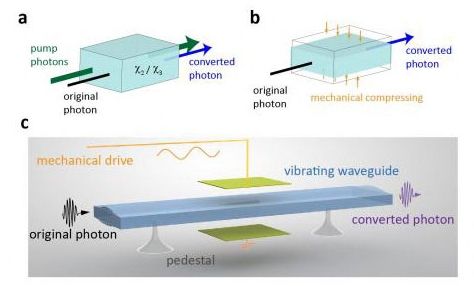Page 10721
Nov 2, 2016
Yale Engineers Advance Quantum Technology With Photon Control
Posted by Karen Hurst in categories: computing, engineering, quantum physics
Engineers from Yale University have developed a new technique to control the frequency of single photons.
The ability to control the frequency of single photons is crucial to realize the potential of quantum communications and quantum computing. The current methods for changing photon frequency, however, bring with them significant drawbacks.
Researchers in the lab of Hong Tang, the Llewellyn West Jones, Jr. Professor of Electrical Engineering & Physics, have developed a technique that avoids these obstacles. The results of their work are published today in Nature Photonics. Linran Fan, a Ph.D. student in Tang’s lab, is the lead author.
Continue reading “Yale Engineers Advance Quantum Technology With Photon Control” »
Nov 2, 2016
Turning pings into packets: Why the future of computers looks a lot like your brain
Posted by Karen Hurst in categories: mobile phones, neuroscience, supercomputing
In the future, circuits and systems modelled on human brains could end up in everything from supercomputers to everyday smartphones.
Nov 2, 2016
Chemists create clusters of organelles
Posted by Karen Hurst in categories: biotech/medical, chemistry, nanotechnology
Scientists from the University of Basel have succeeded in organizing spherical compartments into clusters mimicking the way natural organelles would create complex structures. They managed to connect the synthetic compartments by creating bridges made of DNA between them. This represents an important step towards the realization of so-called molecular factories. The journal Nano Letters has published their results.
Within a cell there are specialized compartments called organelles, as for example nucleus, mitochondria, peroxisomes and vacuoles that are responsible for specific functions of the cell. Almost all sophisticated biological functions of cells are realized by self-organization, a process by which molecules adopt a defined arrangement based on their specific conformations and properties, without outside guidance.
Using self-organization of nano-objects into complex architectures is a major strategy to produce new materials with improved properties or functionalities in fields such as chemistry, electronics and technology. For example, this strategy has already been applied to create networks of inorganic solid nanoparticles. However, so far, these networks were not able to mimic sophisticated structures that have biological functions within the cells and thus have potential application in medicine or biology.
Nov 2, 2016
Synthetic Virus Created to Treat Cancer in Dogs
Posted by Karen Hurst in categories: biotech/medical, finance, genetics
2 November 2016. Two companies partnering with Auburn University developed a synthetic virus to find and destroy tumor cells in a type of bone cancer in dogs. Financial and intellectual property aspects of the agreement between synthetic gene company Gen9 in Cambridge, Massachusetts, design systems developer Autodesk Inc. in San Rafael, California, and Auburn University College of Veterinary Medicine in Alabama were not disclosed.
The research team created a synthetic version of canine adenovirus type 2, or CAV2, a virus usually associated with hepatitis in dogs. In this case, the synthetic CAV-2 virus is designed as an oncolytic virus that finds and attacks cancer cells, while leaving healthy cells and tissue intact. The genome in the organism is believed to be the longest in a functional virus synthesized for cancer research, with about 34,000 base pairs of nucleic acids. The human genome, by comparison, has about 3 billion base pairs.
The technology provided by Gen9 in this project makes it possible to eventually produce synthetic therapeutic viruses tailored for specific patients. Gen9 offers customized gene synthesis and is developing a library of synthesized proteins and antibodies. One of the 4 year-old company’s founders is George Church, a geneticist at Harvard Medical School and serial entrepreneur. In August 2016, as reported in Science & Enterprise, Church and colleagues, including those from Gen9, developed a synthetic E. coli bacteria genome with redundant DNA components removed.
Nov 2, 2016
Inside the Garage Labs of DIY Gene Hackers
Posted by Karen Hurst in categories: bioengineering, genetics
When the future of genetic engineering arrived on Sebastian Cocioba’s doorstep, it was affixed to the back of a postcard from Austria with a little bit of packing tape.
Cocioba is a 25-year-old college dropout whose primary interest is tinkering with plant genetics in a lab he cobbled together from eBay. The lab is located in the spare bedroom of his parent’s lavish apartment in Long Island City, across the river from Manhattan. A few months ago, an internet friend from an online bio-hacking forum had sent him the lab’s latest addition: attached to that postcard was Crispr-Cas9.
Nov 2, 2016
Transhumanist Zoltan Istvan: Formula 1 is Future of Human Sports
Posted by Zoltan Istvan in categories: geopolitics, transhumanism
Inverse doing a recap from my AMA on Reddit’s Futurology. My AMA is going on for about another 15 hours, so if you have a question, please chime in there: https://www.inverse.com/article/23120-zoltan-istvan-formula-1-sports-future and here’s the AMA:
https://www.reddit.com/r/Futurology/comments/5aq3mw/ama_im_z…manist_us/ #transhumanism #AMA #ScienceCandidate #Election2016
The U.S. presidential candidate has shared some of his future goals ahead of voting day.
Continue reading “Transhumanist Zoltan Istvan: Formula 1 is Future of Human Sports” »
Nov 2, 2016
A Supercomputer Just Solved A Big Mystery Behind Dark Matter
Posted by Andreas Matt in categories: cosmology, particle physics, supercomputing
We now know the mass of an axion, which means we might be able to prove dark matter does indeed exist.
Nov 2, 2016
Engineering Viruses to Kill Cancer Cells, Canada-Based Turnstone Raises $41.4M
Posted by Aleksandar Vukovic in categories: bioengineering, biotech/medical
Scientists have been working for decades on engineered viruses that can hunt down and get inside cancer cells, cause them to burst and spur the immune system to mop up whatever malignant cells might be left behind. Only one such treatment has successfully become an FDA-approved cancer treatment.
That one drug, from Amgen, isn’t selling much. But that small victory a year ago has emboldened others to go forward with their own ideas to advance this approach to cancer therapy, known as oncolytic virus therapy.
One of the aspiring players in the oncolytic virus field, Ottawa, Canada-based Turnstone Biologics, is announcing today it has raised $41.4 million in a Series B venture financing. The round was led by OrbiMed Advisors, and included F-Prime Capital Partners and a couple of existing investors, FACIT and Versant Ventures. The new money will add on to the $11.3 million Series A round from a year ago.
Continue reading “Engineering Viruses to Kill Cancer Cells, Canada-Based Turnstone Raises $41.4M” »
Nov 2, 2016
Scientists Hook Up Brain to Tablet—Paralyzed Woman Googles With Ease
Posted by Elmar Arunov in categories: biotech/medical, neuroscience

From time to time, the Singularity Hub editorial team unearths a gem from the archives and wants to share it all over again. It’s usually a piece that was popular back then and we think is still relevant now. This is one of those articles. It was originally published October 25th, 2015. We hope you enjoy it!
















